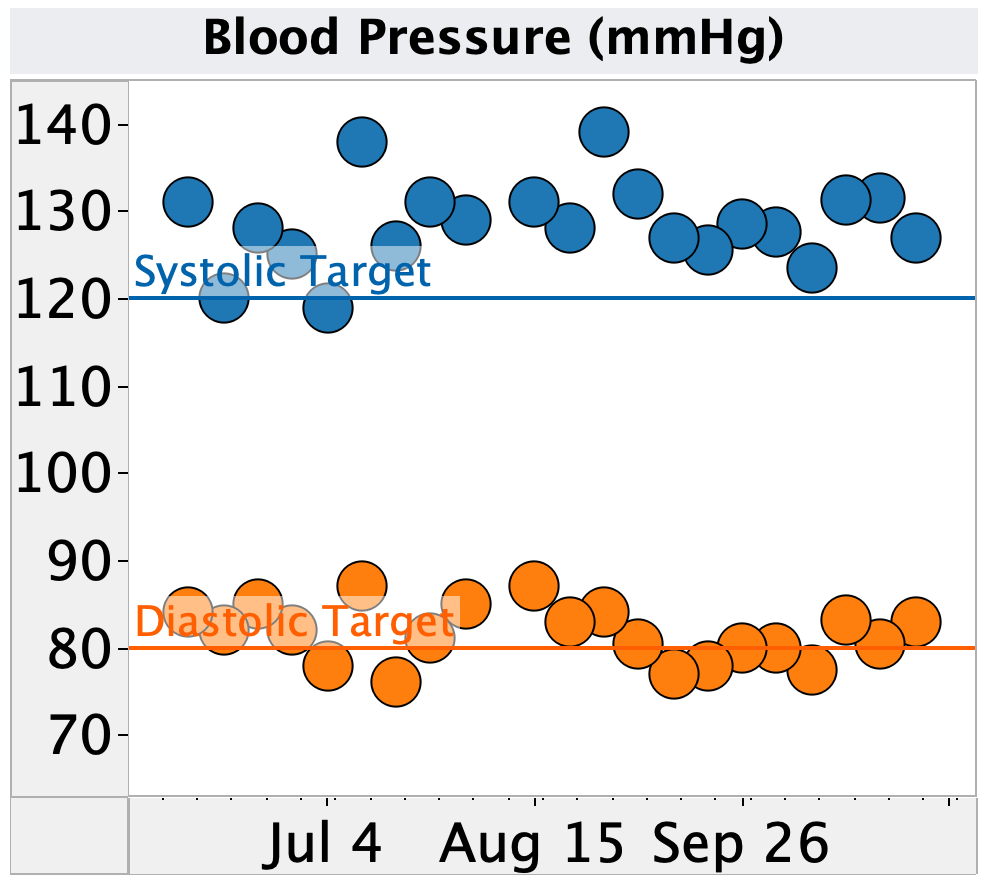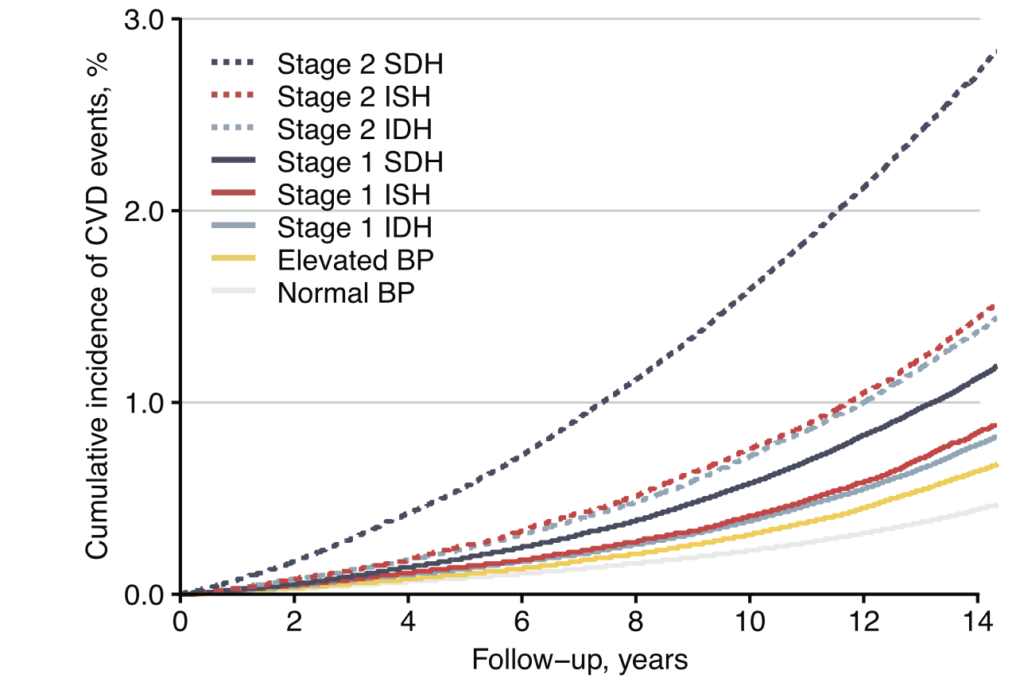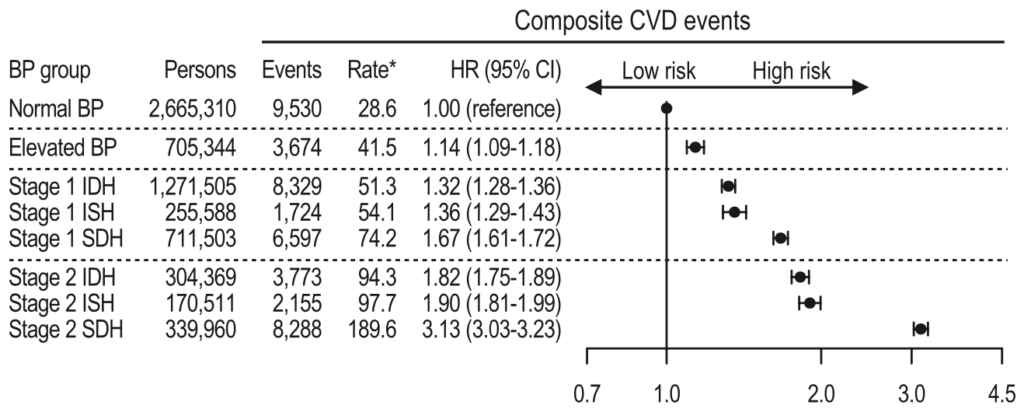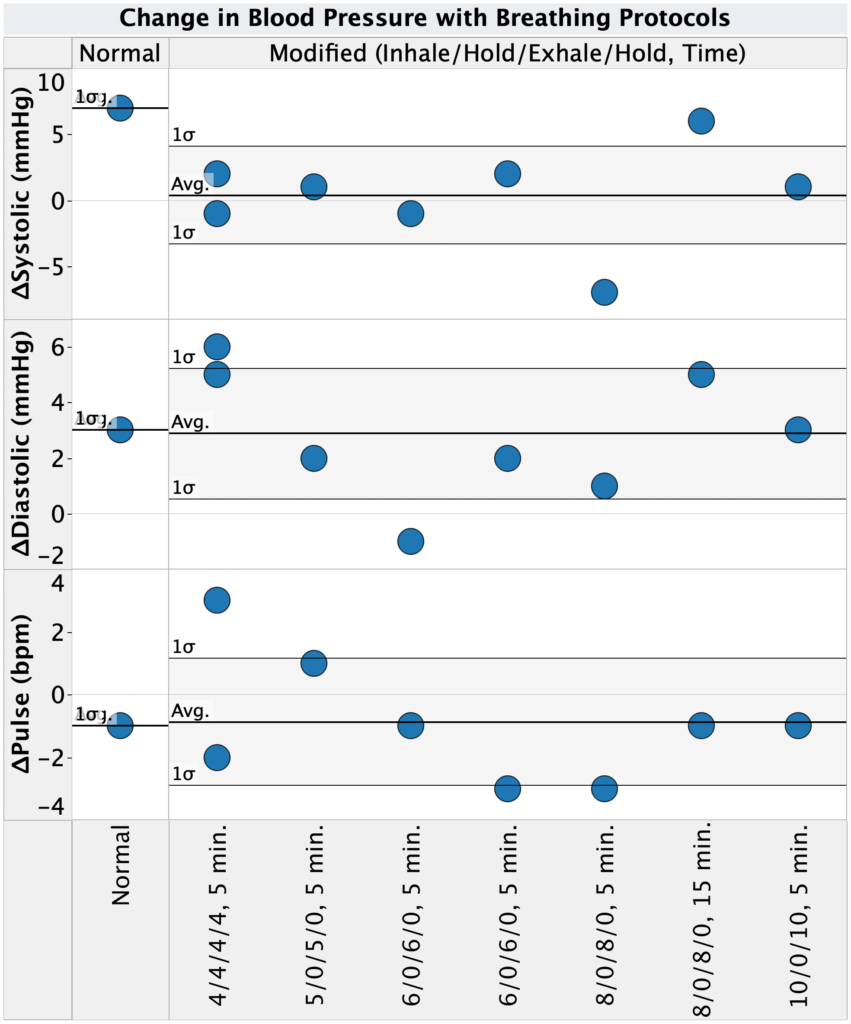Get new posts by email or rss feed
I’ve been measuring my blood pressure over the past 4 months and it’s consistently over the American Heart Association target of 120/80 mmHg for “Normal” blood pressure. Of more concern, I frequently measure Systolic blood pressure of >130 mmHg, which is considered Stage 1 Hypertension.
Previously, I proposed some analyses and breathing experiments to try to identify potential causes for and ways to reduce my high blood pressure. I got great feedback on that post (thanks everyone!) and have also done some preliminary breathing experiments. Based on that, I’ve finalized my experimental and analytical approach and am ready to start. This post will serve as the pre-registration of the experiments.
Details
Purpose
- To identify environmental or controllable factors that have a significant impact on my blood pressure.
- To quantify the effect of known interventions for reducing blood pressure.
- To find a set of interventions that enable me to reduce my blood pressure below 120/80 mmHg.
Background

I’ve been measuring my blood pressure over the past 4 months and it’s consistently over the American Heart Association target of 120/80 mmHg for “Normal” blood pressure. Of more concern, I frequently measure Systolic blood pressure of >130 mmHg, which is considered Stage 1 Hypertension.


Given this, I’d like to see if I can reduce my blood pressure and reduce the strain on my heart and circulatory system.
There are numerous medications that lower blood pressure, but all risk of side effects. Before I pursue that route, I’d like to better understand the cause of my elevated blood pressure and see if any diet or lifestyle interventions can ameliorate it.
As mentioned above, I’ve been measuring my blood pressure for the past 4 months, along with blood glucose, sleep, weight, and exercise. This provides a (hopefully) rich dataset for identifying environmental or lifestyle factors that influence my blood pressure. Notably, I’ve noticed that my blood pressure is elevated on days after I’ve had low blood sugar the night before, indicating a possible effect (no statistical analysis done).
From an American Hearth Association evaluation of methods non-medication approaches to reduce blood pressure, with the exception of aerobic exercise (which I already do), the most well evidenced methods of reducing blood pressure are meditation and deep breathing.
As a quick test of this approach, I did one-off tests of 7 different breathing protocols. I tested one each morning after arriving at work, measuring my blood pressure before and after the protocol. I used the app iBreathe to help regulate my breathing. The results are shown below.

With the exception of one protocol (8s inhale/8s exhale for 5 min.), I did not see a significant drop in blood pressure. However, I saw a large rise in blood pressure (+7/+3 mmHg) when I did not use a breathing protocol. Given this, I think a more extensive experimental test, focused on the longer inhale/exhale time is worth trying.
Proposed Experiments
Phase 1: Identify Potential Causes of Elevated Blood Pressure from Existing Self-Tracking Data
- Data
- Blood pressure:
- systolic and diastolic blood pressure
- Measured by Omron Evolve
- Glucose:
- Same day: fasting BG
- Previous day: average BG, time low (70, 60, & 50), time high (120, 140, 160), & coefficient of variation
- Previous evening (after 7p): same as previous day
- Measured by Dexcom G6
- Sleep:
- Time asleep, number of wake-ups, early rising (time woke before alarm)
- Measured manually and by Apple Watch (less reliable but more data)
- Other heart markers:
- pulse (sleeping, morning, and awake), heart rate variability
- Measured by Apple Watch and Omron Evolve
- Body:
- Weight & waist circumfrence
- Measured by scale + Renpho tape measure
- Exercise:
- Type of exercise the previous day (aerobic vs. strength training) and frequency of aerobic exercise
- Manually recorded
- Blood pressure:
- Analysis
- A mixed effect model will be used to calculate the effect size, standard error, 95% CI, and p-value for the correlation between each metric and systolic and diastolic blood pressure
- Effects will be of significant magnitude if a reduction of 5 mmHg can be achieved via a practical variation in the correlating metric.
- Given the large number of metrics being looked at, I will use p-value thresholds of:
- 0.02 for planning testing interventions
- 0.05 for follow up experiments to confirm the correlation
- 0.1 for further monitoring/assessment as I get more data
Phase 2: Testing Deep Breathing to Lower Blood Pressure
- Background
- Numerous studies, reviews, and meta-analyses have shown deep breathing to lower blood pressure in both the short and long-term (example 1, example 2).
- Effect sizes are moderate (3-5 mmHg) and statistically significant for large patient populations (>10,000 patients in some studies).
- Numerous breathing protocols have been tested, with varying results.
- My own quick tests (see above) suggest a possible effect.
- Approach
- Measure blood pressure and pulse before & after the following protocols:
- 8s inhale, 8s exhale
- Normal breathing (read and do not use app to regulate
- Normal activity
- Each protocol will be tested for 5 & 15 min.
- Each protocol/time combination will be measured five times.
- Conduct measurements 1/day in the mornings.
- If any protocols show significant reduction in blood pressure (>3 mmHg), optimize the protocol and design/execute an experiment to test the long term effect.
- Measure blood pressure and pulse before & after the following protocols:
- Measurement
- Blood pressure and pulse will be measured with an Omron Evolve.
- Analysis
- Student’s t-test will be used to test if the blood pressure change for any of the protocols is different from that of normal breathing.
These experiments will start this week, so I expect to have results to share in ~4 weeks.
– QD